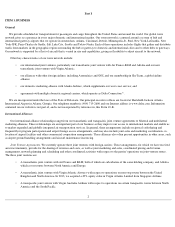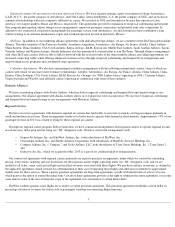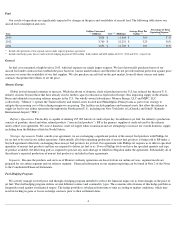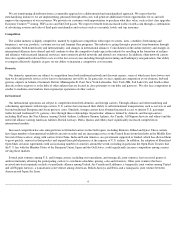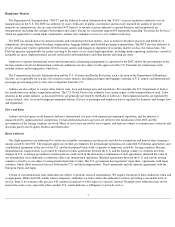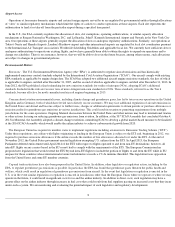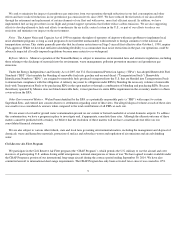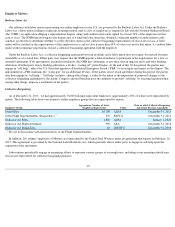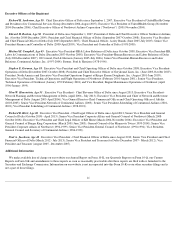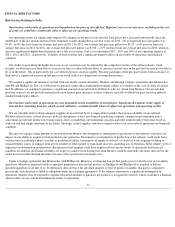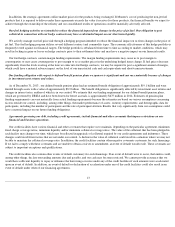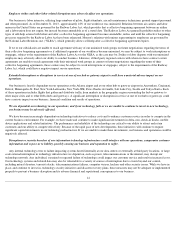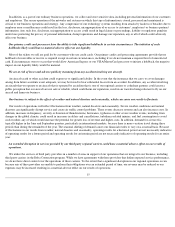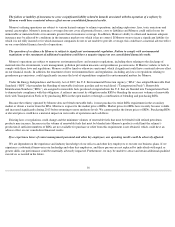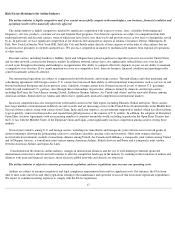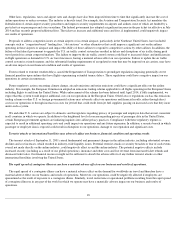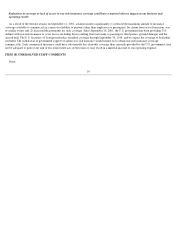Delta Airlines 2013 Annual Report Download - page 15
Download and view the complete annual report
Please find page 15 of the 2013 Delta Airlines annual report below. You can navigate through the pages in the report by either clicking on the pages listed below, or by using the keyword search tool below to find specific information within the annual report.
We seek to minimize the impact of greenhouse gas emissions from our operations through reductions in our fuel consumption and other
efforts and have realized reductions in our greenhouse gas emission levels since 2005. We have reduced the fuel needs of our aircraft fleet
through the retirement and replacement of certain elements of our fleet and with newer, more fuel efficient aircraft. In addition, we have
implemented fuel saving procedures in our flight and ground support operations that further reduce carbon emissions. We are also supporting
efforts to develop alternative fuels and efforts to modernize the air traffic control system in the U.S., as part of our efforts to reduce our
emissions and minimize our impact on the environment.
Noise . The Airport Noise and Capacity Act of 1990 recognizes the rights of operators of airports with noise problems to implement local
noise abatement programs so long as such programs do not interfere unreasonably with interstate or foreign commerce or the national air
transportation system. This statute generally provides that local noise restrictions on Stage 3 aircraft first effective after October 1, 1990, require
FAA approval. While we have had sufficient scheduling flexibility to accommodate local noise restrictions in the past, our operations could be
adversely impacted if locally-imposed regulations become more restrictive or widespread.
Refinery Matters
. Monroe's operation of the Trainer Refinery is subject to numerous environmental laws and extensive regulations, including
those relating to the discharge of materials into the environment, waste management, pollution prevention measures and greenhouse gas
emissions.
Under the Energy Independence and Security Act of 2007, the U.S. Environmental Protection Agency (“EPA”) has adopted Renewable Fuel
Standards (“RFS”) that mandate the blending of renewable fuels into gasoline and on-road diesel ("Transportation Fuels"). Renewable
Identification Numbers (“RINs”) are assigned to renewable fuels produced or imported into the U.S. that are blended into Transportation Fuels
to demonstrate compliance with this obligation. A refinery may meet its obligation under RFS by blending the necessary volumes of renewable
fuels with Transportation Fuels or by purchasing RINs in the open market or through a combination of blending and purchasing RINs. Because
the refinery operated by Monroe does not blend renewable fuels, it must purchase its entire RINs requirement in the secondary market or obtain
a waiver from the EPA.
Other Environmental Matters . We had been identified by the EPA as a potentially responsible party (a “PRP”) with respect to certain
Superfund Sites, and entered into consent decrees or settlements regarding some of these sites. Our alleged disposal volume at each of these sites
was small or was considered de minimis when compared to the total contributions of all PRPs at each site.
We are aware of soil and/or ground water contamination present on our current or former leaseholds at several domestic airports. To address
this contamination, we have a program in place to investigate and, if appropriate, remediate these sites. Although the ultimate outcome of these
matters cannot be predicted with certainty, we believe that the resolution of these matters will not have a material adverse effect on our
consolidated financial statements.
We are also subject to various other federal, state and local laws governing environmental matters, including the management and disposal of
chemicals, waste and hazardous materials, protection of surface and subsurface waters and regulation of air emissions and aircraft drinking
water.
Civil Reserve Air Fleet Program
We participate in the Civil Reserve Air Fleet program (the “CRAF Program”), which permits the U.S. military to use the aircraft and crew
resources of participating U.S. airlines during airlift emergencies, national emergencies or times of war. We have agreed to make available under
the CRAF Program a portion of our international long-range aircraft during the contract period ending September 30, 2014. We have also
committed aircraft to international short-range requirements. The CRAF Program has only been activated twice since it was created in 1951.
9





